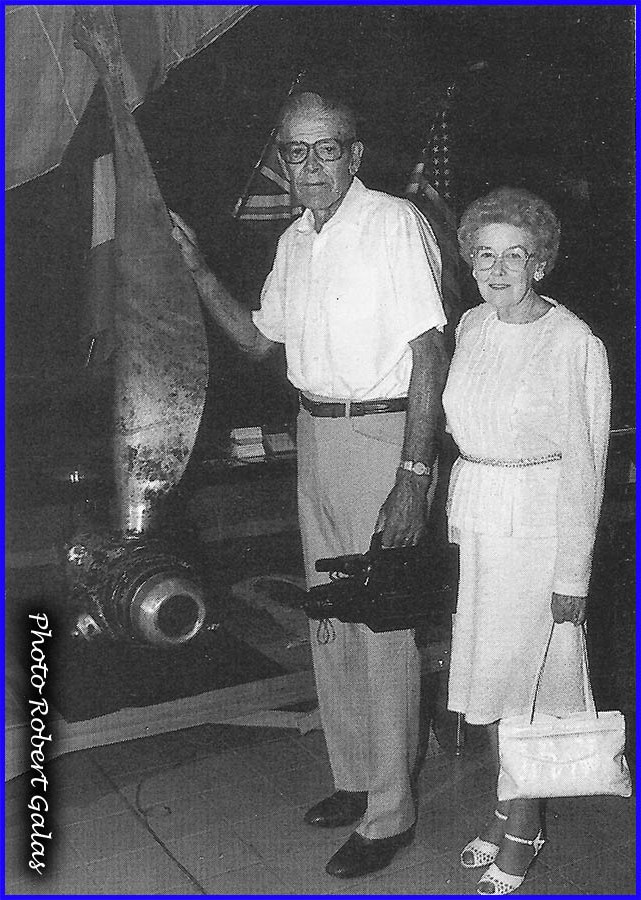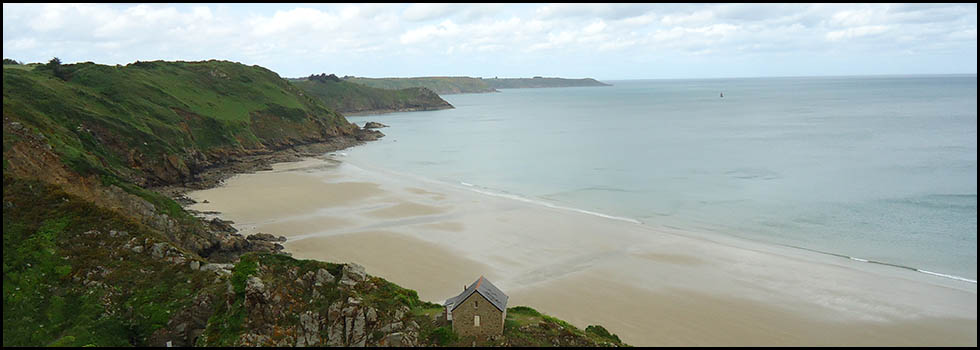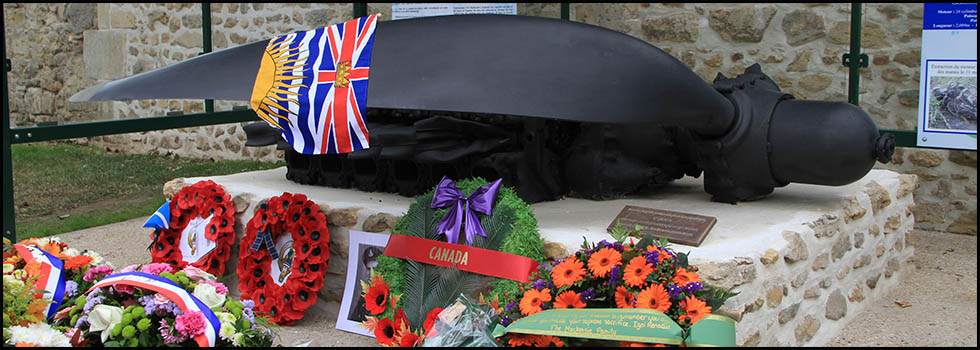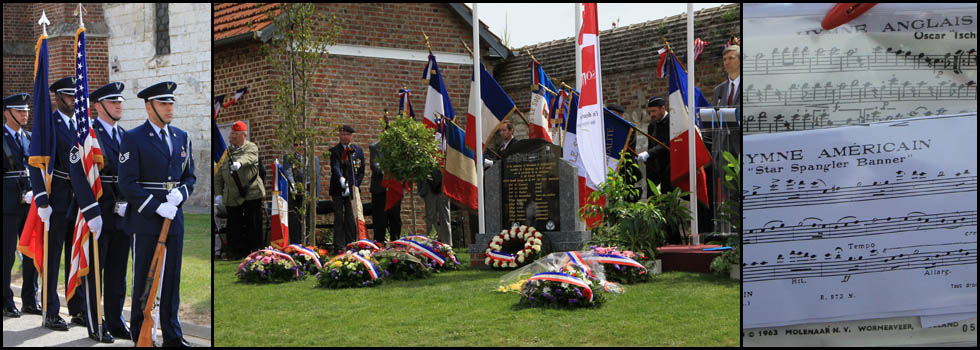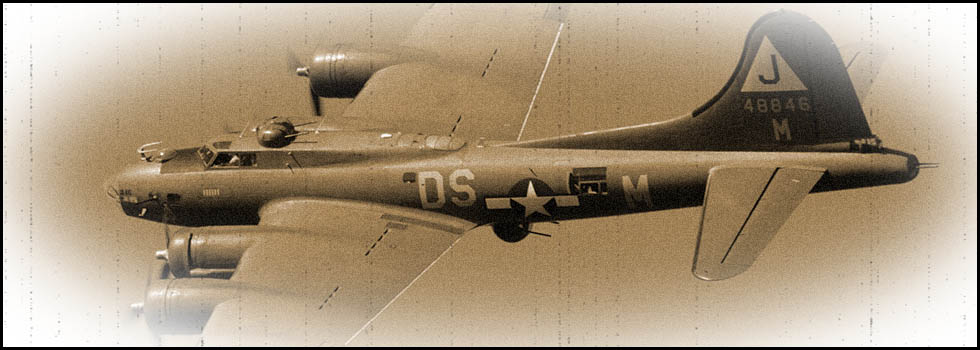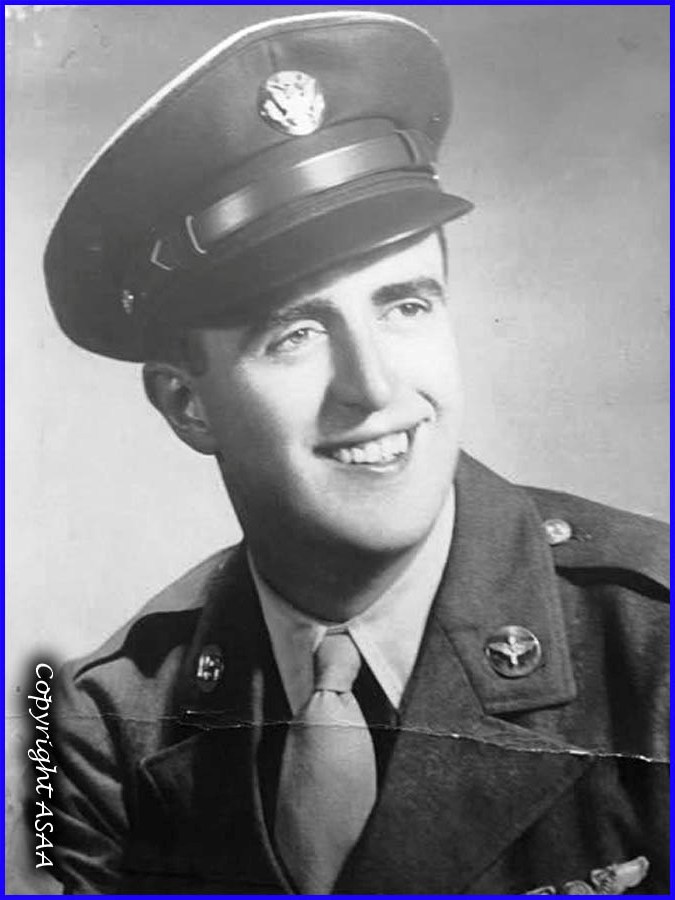27th June 1944
B-24H “Liberator” # 42-95280 “Square Dance”
445th Bomb Group
701st Bomb Squadron
8th Air Force
Mello (Oise)
On 27th June 1944, early in the afternoon, about forty B-24 "Liberator" heavy bombers took off from different bases scattered in England. Their target: to bomb, in two waves, the marshalling yards of the Petit Thérain, near Creil. The four-engined aircraft of the 445th Bomb Group of the 8th Air Force based at Tibenham, Norfolk, participated in the raid.
Among them, the B-24 "Liberator" # 42-95280 "Square Dance".
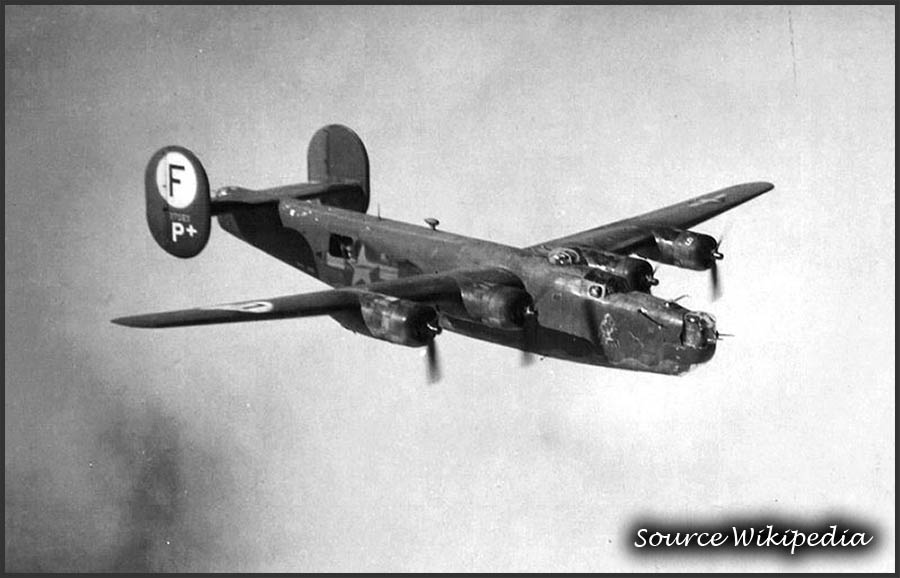
| 1st Lt. Clifton G. MILLER | Pilot | 22 | Evaded | Belding, Michigan |
| 2nd Lt. Ralph L. HALL | Co-pilot | 22 | Evaded | Lakewood, Ohio |
| 1st Lt. Arlee T. RENO | Navigator | 24 |
KIA | Spring Lake City, New Jersey |
| 2nd Lt.Walter A. STRYCHASZ | Bombardier | 26 | KIA | Cleveland, Ohio |
| T/Sgt. John H. LEAHY | Radio-operator | 32 | KIA | Chicago, Illinois |
| T/Sgt. Wayne E. BRAND | Top turret gunner | 23 | Evaded | Dublin, Mississippi |
| Cpl Edward L. SMITH | Ball turret gunner | 24 | POW | Monessen, Pennsylvanie |
| S/Sgt. Walter B. SCHUM | Waist gunner | 20 | KIA | Altoona, Pennsylvanie |
| S/Sgt. William H. SALIO | Waist gunner | POW | Cincinnati, Ohio | |
| S/Sgt. John F. GOAN | Tail gunner | 23 | Evaded | Chattanooga, Tennessee |
Near the target, the German anti aircraft defense opened fire. The 88 mm shells burst at high altitude, trying to shoot down the approaching allied aircraft.
At about 24,000 ft, the B-24H "Square Dance", piloted by 1st Lt. Clifton G. Miller, managed to drop, as scheduled, its load of bombs which whistled down towards the target despite the deadly bursts of the formidable enemy ante-aircraft defenses.
Moments later, the bomber was hit violently by a shell that exploded between the bomb bay and the nose of the aircraft. The B-24 ignited immediately. 1st Lt. Arlee T. Reno and 2nd Lt. Walter A. Strychasz were instantly killed at their posts.
The situation was desperate. The order was given by the pilot to evacuate the uncontrollable aircraft. The surviving airmen baled out one after the other just before the explosion of the plane in mid air directly above the village of Mello.
T/Sgt. John H. Leahy apparently lost his life at that time. Seen for the last time by his companions in the process of putting on his parachute, he tried right to the end to fight the flames that ravaged the bomb bay.
T/Sgt. John H. Leahy, radio-operator
Debris from the aircraft fell on a large area around the "Champ des Roses”, in the park of the Mello chateau. It was about 7:30 pm.

Part of the wreck of the B-24 "Square Dance"
The bodies of the three airmen were taken out from the debris by the German Army. They will be buried on 29th June in the cemetery of Creil. They will stay there until the end of the war.
The bodies of Walter Strychasz and John Leahy were repatriated to the United States. Walter Strychasz now rests in Cleveland, Ohio, and John Leahy in Forrest Park, Illinois.
According to the testimony of Gilbert Marionval of the “Valmy” Resistance Group S/Sgt. Walter B. Schum landed in Cauffry and had a broken leg. He was initially rescued by the local population. The Germans arrived quickly and took him to the Château des Rochers in Nogent-sur-Oise, which had been transformed into a hospital for the wounded soldiers evacuated from the Normandy front. Bearing a Star of David around his neck, S/Sgt. Schum was executed by the Germans the next day.
Another source mentions that the body of an airman was found near the hamlet of Barisseuse. Was it that of S/Sgt. Walter B. Schum ? There is nothing to confirm this and the mystery remains.
Like his three unfortunate crewmates, S/Sgt. Walter B. Schum was buried in the cemetery of Creil on 29th June.
Exhuming his body in the weeks after the Liberation, a US investigative commission found that he had had his throat cut. The investigation classified this as a "war crime."
S/Sgt. Walter B. Schum now rests in Altoona, Pennsylvania.
Shortly after landing, S/Sgt. William H. Salio was captured by the Germans near Pont-Sainte-Maxence and then transferred to a hospital in Beauvais. Corporal Edward L. Smith came down near Rantigny where he was taken by the enemy. Both airmen were subsequently sent to prison camps in Germany until the end of the war. Corporal Smith will be notably held at Stalag Luft IV, Pomerania, today in Poland.
The other four airmen were more lucky. Rescued by the population as soon as they had landed, they were handed over to structured Resistance organizations.
The postwar testimonies of S/Sgt. Goan and 2nd Lt. Hall allow us to better understand how they were able to escape the enemy after landing on French soil.
S/Sgt. John F. Goan dragged himself out of the rear turret of the B-24 and managed to open his parachute after floating a moment in the air. During his descent, he noticed a broken wing of the aircraft plunging to the ground.
2nd Lt. Ralph L. Hall evacuated the aircraft shortly after S/Sgt. Goan. He soon realized that in his rush, he had put his parachute on back to front. However, he managed to pull the ripcord which was behind him. When the parachute deployed, he realized that it was only hooked on to one side of his harness. He could only see S/Sgt. Goan a short distance below him, floating down to the ground, suspended by his parachute.
S/Sgt. Goan landed hard and was knocked out temporarily. When he regained consciousness, a young girl was near him. She quickly helped him to take off his parachute harness and pointed to a nearby wood to where he should run.
2nd Lt. Hall gently landed a few yards from S/Sgt. Goan. Having taken off his harness, French people rushed to help him. He joined his companion who had hurt his back. The girl helped him to get up and both airmen headed for the woods. 2nd Lt. Hall had lost his boots and gloves during his fall.
Under the trees, S/Sgt. Goan dug a hole and hid their equipment, keeping only their escape kit. Then the two airmen sunk deeper into the woods to spend the night.
Early the next morning they met a Frenchman who gave them food. They were then taken to the barn of a farm run by the Matthys family in the hamlet of Barisseuse, near Saint-Vaast-les-Mello. Dr. Jean Pichon, from Mello, came to examine the two airmen and promised to come back the next day. In the evening, Father Claude, who spoke English, visited them and told them they were going to stay there for the night. Both Americans were provided with civilian clothes.
Back the next day, the priest took them to his home. Both airmen will stay there for nine days.
The escape route of 2nd Lt. Ralph L. Hall and S/Sgt. John F. Goan continued through Chantilly where they were put up by Louis Mesureur "Louis le coiffeur" in the rue du Connetable, then through Saint-Leu-d'Esserent where they were taken in charge by the Cochet family. They were then conveyed to the 17th arrondissement of Paris, at the home of Madame Yvonne Diximier. In late July, the two Americans were taken to the camp of Freteval (Loir-et-Cher) pending the arrival of the liberating Allied troops.
Immediately opening his parachute to extinguish the flames of his burning flight suit, the wind made T/Sgt. Wayne E. Brand drift away. He landed near the village of Angicourt. In the region, he met his pilot, 1st Lt. Clifton G. Miller, a few days later. The route of his escape is not clear but he, too, joined the Freteval camp.
1st Lt. Clifton G. Miller, leaving the controls, managed to get to the flaming bomb bay and threw himself into the void. He landed by parachute on the hillside of the village of Laigneville with an injured leg and his face burned.
Witnessing of his fall, the Wattier family immediately went to his aid. They summarily treated him before the pilot went to hide in a nearby wood for the night to escape the German searches.
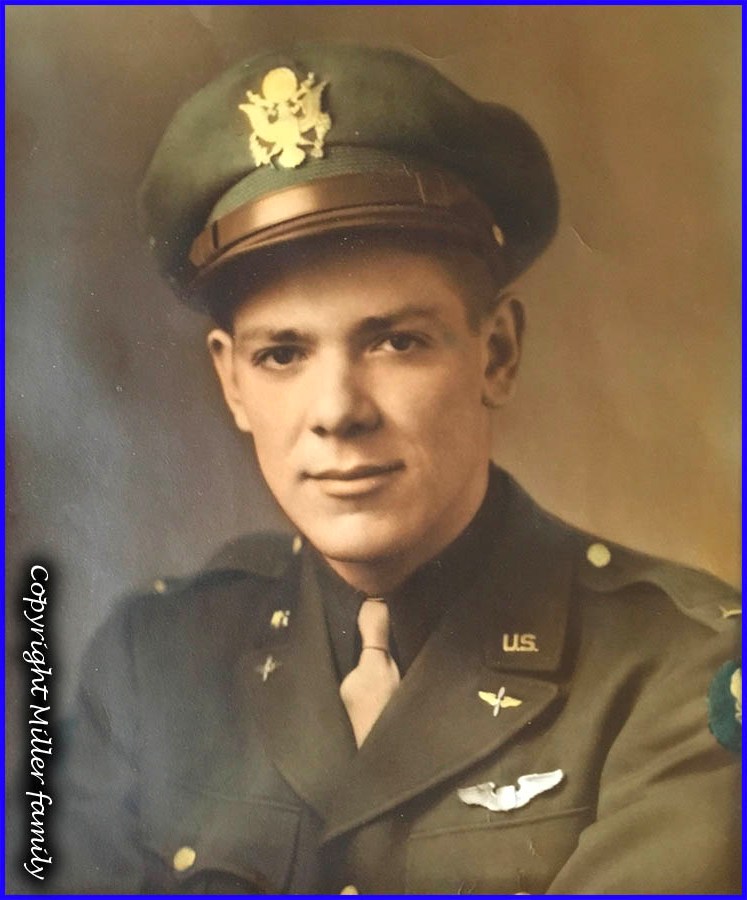
1st Lt. Clifton G. Miller
The next morning, 1st Lt. Miller again met Mrs Marcelle Wattier who put him up for three days. A former nurse during World War I, she treated the wounds of the airman with the help of Dr. Aubry, from Liancourt.
Notified of the presence of the American pilot, Gilbert Marionval, of the “Valmy” Group, came to take him in charge, accompanied by two friends : Rene Mallet and Marcel Defrance. The pilot, covered with a blanket and chairs, was transported right under German’s noses in a handcart to Irene Marionval, Gilbert’s mother, in rue du Paleron, Nogent-sur-Oise.
Wounded, 1st Lt. Miller was unable to continue his escape. He was hidden in a room in the rear of the house and forbidden to go out. Often elements of Hitler Youth paraded in the streets and no risk whatsoever could be taken. Dr. Jean Bell came to visit him for treatment from time to time.
1st Lt. Clifton G. Miller remained hidden among the Marionval family for many days but on 24th July, the Gestapo arrested a neighbour who was denounced as a resistant. As a precaution, the airman was first taken to Fernand Belloy who lived in the same street and then to the Parrot family, in the rue Pasteur. Later, he was moved again. He stayed with the Thellier family before one day Dr. Georges Debray came to get him. He took him to Laure Vacher and Henriette Giral, in Creil. Throughout his journey, Dr. Bell continued to tend to the wounds of the airman. After several days, he was brought back to the home of the Marionval family, in Nogent, who took him in charge until 31st August, the day the town was liberated. 1st Lt. Miller was then picked up by his countrymen and then repatriated to England before returning to the United States.
In September 1991, Clifton G. Miller returned to the Creil region, accompanied by his wife, so as to thank personally and with deep feelings of gratitude, his rescuers who took so many risks to save him during the course of the summer of 1944.
